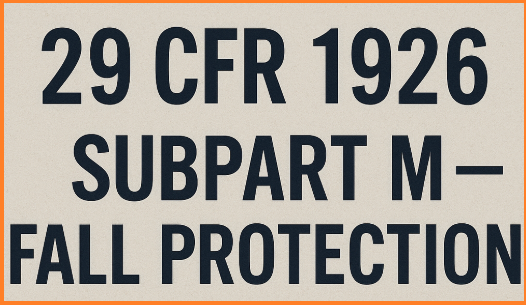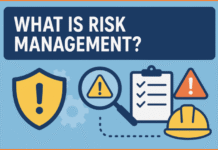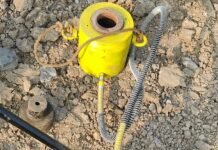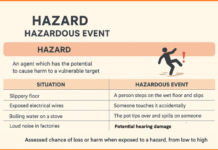In the U.S., 29 CFR Part 1926 contains OSHA safety and health regulations for the construction industry. Within that, Subpart M specifically addresses Fall Protection — one of the most critical hazards in construction work.
Falls remain a leading cause of fatalities and serious injuries in construction. Subpart M sets forth requirements for when, where, and how fall protection must be provided, the systems that must be used, and training requirements.
This article breaks down Subpart M into its key sections, explains practical implications and challenges, and offers guidance for compliance.
Contents
Structure of Subpart M
Subpart M is organized into three main sections plus appendices:
| Section | Title | Purpose |
|---|---|---|
| § 1926.500 | Scope, application, and definitions | Defines the boundaries, exceptions, and key terms |
| § 1926.501 | Duty to have fall protection | Specifies when fall protection must be used |
| § 1926.502 | Fall protection systems criteria and practices | Technical requirements for the various systems |
| § 1926.503 | Training requirements | Requirements for training employees in fall protection |
Additionally, Appendices A through E provide illustrative, supplemental, or example materials (e.g. roof width determinations, sample plans, system diagrams).
§ 1926.500 — Scope, Application, and Definitions
Scope & Application
- Subpart M applies to construction workplaces covered under Part 1926, with exceptions.
- It does not apply when employees are merely inspecting, investigating, or assessing conditions before construction starts or after construction is complete.
- Some fall protection situations are instead covered by other subparts:
- Scaffolds → Subpart L
- Cranes / derricks → Subpart CC
- Steel erection → Subpart R (except towers & tanks)
- Tunneling-related equipment → Subpart S
- Erection of tanks / towers → specialized sections (§ 1926.105, etc.)
- Stairways / ladders → Subpart X
Key Definitions
Definitions are crucial, as they clarify what terms like “fall arrest,” “leading edge,” “controlled access zone,” etc. mean in regulatory context. Some important definitions:
- Anchorage: A secure point of attachment for fall arrest systems.
- Body harness vs body belt: A harness distributes forces over various body parts; after January 1, 1998, body belts are prohibited for personal fall arrest systems.
- Connector: A device (e.g. carabiner, snap-hook) used to couple parts of a fall protection system.
- Controlled Access Zone (CAZ): A zone in which certain work can occur without full fall protection, but access is restricted and controlled.
- Deceleration device: A mechanism (rope grab, tearing lanyard, automatic device) that dissipates energy during fall arrest.
- Free fall: The distance an employee falls before the fall arrest system begins to act.
- Leading edge: The edge of a floor, roof, or formwork that changes as construction progresses.
- Low-slope roof: A roof of slope ≤ 4 in 12 (vertical to horizontal).
- Steep roof: A roof with slope > 4 in 12.
- Warning line system: A line erected to warn workers they are approaching an unprotected roof edge, marking an area where fall protection is required.
These definitions provide the foundation for interpreting the rest of Subpart M.
§ 1926.501 — Duty to Have Fall Protection
This section spells out the when — the conditions under which an employer must provide fall protection, and what types of systems are acceptable.
General Requirement
- Employers must evaluate walking/working surfaces to ensure they have sufficient strength/structural integrity before allowing employees to work on them.
- If a walking/working surface has an unprotected side or edge and the potential fall to a lower level is 6 feet (1.8 m) or more, fall protection must be provided.
Specific Situations
Subpart M enumerates many scenarios where fall protection is mandated; some examples:
- Leading edges: Workers constructing or working at leading edges (≥ 6 ft above lower levels) need guardrails, safety nets, or personal fall arrest. If those are infeasible, a fall protection plan per § 1926.502(k) is required.
- Workers not engaged in the leading edge work but exposed must also have protection.
- Hoist areas: If employees are in hoist areas and ≥ 6 ft from lower levels, guardrails or personal fall arrest systems are required. If guardrails are temporarily removed, a personal fall arrest system must protect those leaning or reaching.
- Holes (including skylights): Employees must be protected from falling through holes by guardrails, covers, or fall arrest systems. Covers must also prevent tripping or stepping into holes.
- Formwork / reinforcing steel: Workers on faces of formwork or rebar must be protected if ≥ 6 ft above.
- Ramps, runways, walkways: These must have guardrail systems if ≥ 6 ft above lower levels.
- Excavations: Edges of excavations ≥ 6 ft deep require guardrails, fences, or barricades (especially if not readily visible).
- Dangerous equipment: If there is equipment below a work surface, employees must be protected from falling into or onto it.
- Overhand bricklaying / related work: If ≥ 6 ft above lower levels, employees must be protected via guardrails, nets, fall arrest systems, or in a controlled access zone. Also, if reaching more than 10 in below the working surface, protection is required.
- Roofing on low-slope roofs: Workers must be protected by guardrails, safety nets, personal fall arrest, or combinations involving warning lines, safety monitoring systems, etc. On roofs ≤ 50 ft in width, a safety monitoring system alone may be allowed.
- Steep roofs: Workers must be protected using guardrails (with toeboards), safety nets, or personal fall arrest systems.
- Precast concrete erection: Similar to other work, protection is required unless infeasible; then a fall protection plan may substitute.
- Residential construction: Workers ≥ 6 ft above lower levels require protection unless employer demonstrates infeasibility.
- Wall openings: If the bottom edge of the opening is ≥ 6 ft above lower levels and the interior edge is < 39 in above the working surface, protection must be in place (guardrails, nets, or fall arrest).
- Other walking/working surfaces: For surfaces not otherwise addressed, if ≥ 6 ft above lower levels, guardrails, nets or personal fall arrest systems must be used.
Protection from Falling Objects
- If workers are exposed to objects falling from above, employers must take measures such as:
- Toeboards, screens, guardrails;
- Canopy structures, or repositioning objects away from edges;
- Barricading zones below to prevent entry.
§ 1926.502 — Fall Protection Systems Criteria & Practices
This section is the core technical standard. It sets out requirements for design, erection, use, maintenance, inspection, and performance of different fall protection systems.
(a) General
- Employers must comply with the provisions in § 1926.502 for any fall protection system required under Subpart M.
- Systems must be provided before the employee begins work that requires fall protection.
(b) Guardrail Systems
Requirements for guardrails include:
- Top edge height: 42 in (plus or minus 3 in) above walking surface.
- Midrails, screens, mesh, or intermediate members when no parapet wall ≥ 21 in high.
- Top rails must withstand 200 lb (890 N) applied outward or downward, without failure.
- Under downward load, top edge must not deflect to less than 39 in above surface.
- Midrails, screens, etc., must withstand 150 lb (666 N) downward/outward load.
- Surfaces must prevent injuries (no sharp edges), avoid snagging clothing.
- Ends of rails must not overhang posts (unless not a hazard). (eCFR)
- No steel banding or plastic banding as rails. (eCFR)
- Rails must have minimum thickness (≥ ¼ in), wire rope must be flagged every 6 ft. (eCFR)
- At hoisting areas, a chain or removable guardrail must block access when hoisting isn’t happening. (eCFR)
- Around holes, guardrails must be on all unprotected sides and edges. (eCFR)
- Holes used for material passage: at most two sides may have removable guardrails; when not in use, cover or guardrail all sides. (eCFR)
- Holes used for access (ladderways): guardrail with gate or offset so person cannot walk directly into hole. (eCFR)
- On ramps, runways: guardrails on each unprotected side. (eCFR)
- If rope or wire is used in rails, inspect regularly to maintain strength thresholds. (eCFR)
(c) Safety Net Systems
Key requirements:
- Nets installed as close as practicable under the work surface; max 30 ft below working surface. (eCFR)
- Horizontal extension: nets must extend outward from the work edge by minimum distances, depending on drop height (e.g. up to 5 ft drop → net 8 ft outward; more than 5 ft up to 10 ft drop → 10 ft outward; beyond 10 ft drop → 13 ft outward) (eCFR)
- Adequate clearance under the net must prevent workers contacting the lower surface. (eCFR)
- The net system (net + installation) must absorb impact per drop-test requirements: drop a 400 lb (≈180 kg) bag of sand from the working surface to test the net’s performance. (eCFR)
- Drop tests must be done:
- After initial installation and before first use,
- After relocation,
- After major repair,
- At least every 6 months if left in place. (eCFR)
- If drop test is unreasonable, a competent person can certify compliance (with records). (eCFR)
- Safety nets must be inspected weekly for damage; defective parts removed. (eCFR)
- Mesh openings: at most 36 in², and no dimension > 6 in; all mesh crossings must be secured. (eCFR)
- Border ropes must have breaking strength ≥ 5,000 lb. (eCFR)
- Connections between panels must be as strong as the net and spaced ≤ 6 in apart. (eCFR)
(d) Personal Fall Arrest Systems (PFAS)
PFAS are widely used. Requirements include:
- Body belts: prohibited for fall arrest (but may be used in positioning systems) since Jan 1, 1998. (eCFR)
- Connectors: drop-forged or equivalent, corrosion-resistant, edges smooth. (eCFR)
- Dee-rings and snap-hooks must have minimum tensile strength of 5,000 lb (22.2 kN). (eCFR)
- Dee-rings / snap-hooks must be proof-tested at 3,600 lb without cracking or permanent deformation. (eCFR)
- Snap-hooks must be locking type (to prevent inadvertent disengagement). (eCFR)
- Snap-hooks should not be engaged:
- Directly to webbing, rope, or wire rope,
- To another snap-hook,
- To a dee-ring already having another connector,
- To a horizontal lifeline,
- To an object that could depress the snap-hook keeper. (eCFR)
- Horizontal lifelines: must be designed and used under supervision of a qualified person, as part of a complete fall arrest system, maintaining a safety factor of at least 2. (eCFR)
- Lanyards & vertical lifelines: minimum breaking strength 5,000 lb. (eCFR)
- For vertical lifelines, each employee must typically be attached to a separate line (with limited exception in elevator shaft work). (eCFR)
- Lifelines must be protected from cuts or abrasion. (eCFR)
- Self-retracting lifelines / lanyards that limit free fall to ≤ 2 ft must sustain 3,000 lb; others (rip-stitch, non-self retracting) must sustain 5,000 lb. (eCFR)
- Ropes/webbing in lanyards or strength components must be synthetic fibers. (eCFR)
- Anchorages must be independent of platform support, and capable of supporting at least 5,000 lb per attached employee, unless part of a full system designed with a safety factor. (eCFR)
- PFAS must:
- Limit maximum arresting force:
- 900 lb if used with body belt (though belts cannot be used for arrest),
- 1,800 lb if used with harness. (eCFR)
- Be rigged so the fall distance is ≤ 6 ft, and the deceleration distance ≤ 3.5 ft. (eCFR)
- Be strong enough to withstand twice the potential impact energy of a 6 ft free fall (or the permitted free-fall distance). (eCFR)
- Limit maximum arresting force:
- For systems in compliance with Appendix C (and total weight < 310 lb), they’re considered compliant. If total weight ≥ 310 lb, modifications are needed. (eCFR)
- Attachment point on body harness must be located in the center back (near shoulder level) or above head. (eCFR)
- PFAS components subjected to impact must be immediately removed and inspected before reuse. (eCFR)
- PFAS must be inspected before each use; defective parts removed. (eCFR)
- PFAS must not be attached to guardrail systems or hoists (except in specified cases). (eCFR)
- When used in hoist areas, the system must allow movement only as far as the walking surface edge. (eCFR)
(e) Positioning Device Systems
Positioning device systems (e.g. work positioning) allow an employee to be supported on an elevated vertical surface:
- Must be rigged so the employee cannot free fall more than 2 ft. (eCFR)
- Anchorages must support twice the potential impact load or 3,000 lb, whichever is greater. (eCFR)
- Connectors must meet similar strength, finish, and quality criteria as PFAS connectors. (eCFR)
- Snap-hooks must be locking, etc. (similar restrictions as PFAS). (eCFR)
- Positioning systems must be inspected before each use; defective components removed. (eCFR)
- Body belts, harnesses, components used in positioning systems must not be used to hoist materials. (eCFR)
(f) Warning Line Systems
A warning line is used predominantly on low-slope roofs in conjunction with other fall protection. Key provisions:
- Warning line erected around all sides of the roof work area. (eCFR)
- When mechanical equipment is not used, line must be ≥ 6 ft from roof edge; when equipment is used, distances vary (e.g. ≥ 6 ft parallel, ≥ 10 ft perpendicular). (eCFR)
- Access, material handling, storage, hoisting paths must be connected via access path formed by two warning lines. (eCFR)
- When path isn’t in use, a barricade equivalent to the warning line must block direct access. (eCFR)
- Lines (rope, wire, chain) must be flagged every 6 ft with high-visibility material. (eCFR)
- Lines must be rigged so the lowest point (including sag) is ≥ 34 in above surface, highest ≤ 39 in. (eCFR)
- Stanchions must resist 16 lb horizontal force at 30 in above surface, without tipping. (eCFR)
- Line must have minimum tensile strength 500 lb (2.22 kN). (eCFR)
- Pulling on one segment must not slacken adjacent segments before tipping a stanchion. (eCFR)
- No employee can go into the zone between roof edge and warning line unless performing roofing work. (eCFR)
- Mechanical equipment may only be used or stored in areas protected by warning lines, guardrails, or fall arrest systems. (eCFR)
(g) Controlled Access Zones (CAZ)
CAZ are used to control employee access when full fall protection is impractical. Requirements:
- The zone must be defined by control lines or other means. (eCFR)
- Control lines for leading edge operations must be 6 ft to 25 ft from the edge (or special distances in precast erection). (eCFR)
- Lines must run parallel to the unprotected or leading edge and connect to guardrails or walls. (eCFR)
- For overhand bricklaying, control lines must be 10 ft to 15 ft from the working edge. (eCFR)
- Control lines must be flagged every 6 ft, rigged so lowest point ≥ 39 in, highest ≤ 45 in (or 50 in in some cases). (eCFR)
- Lines must have minimum breaking strength 200 lb. (eCFR)
- On surfaces where guardrails will later be installed, only portions removed for current work may be removed. (eCFR)
(h) Safety Monitoring Systems
Used primarily in roofing work on low-slope roofs if other systems are infeasible:
- A competent person is designated to monitor and warn workers of fall hazards. (eCFR)
- The monitor must:
- Recognize fall hazards,
- Warn employees when unsafe,
- Be on same walking surface and within visual & verbal communication distance,
- Not have other duties that distract from monitoring. (eCFR)
- Equipment must not be used/stored in areas under safety monitoring. (eCFR)
- Only roofing workers (or those under a fall protection plan) allowed in areas monitored. (eCFR)
- Employees in CAZ must comply with warnings from the monitor. (eCFR)
(i) Covers
Covers for holes must meet:
- In roadways / vehicular aisles: support at least 2× the maximum axle load. (eCFR)
- Other covers: support 2× the weight of employees, equipment, materials. (eCFR)
- Must be secured to prevent displacement (wind, equipment, employees). (eCFR)
- Marked (e.g. “HOLE” / “COVER”) or color-coded. (eCFR)
- Does not apply to cast iron manhole covers or street grates. (eCFR)
(j) Protection from Falling Objects (Continuing from § 1926.501)
- Toeboards along overhead edges to protect below. (eCFR)
- Toeboards must withstand 50 lb downward/outward. (eCFR)
- Toeboards: minimum height 3.5 in, openings not more than 1 in, maximal ¼ in clearance above surface. (eCFR)
- If materials extend above toeboard level, additional screening or panels must be used. (eCFR)
- Guardrail systems used for falling object protection must have small openings to prevent object passage. (eCFR)
- Overhand bricklaying: no materials stored within 4 ft of working edge; debris cleared regularly. (eCFR)
- Roofing work: no materials stored within 6 ft of edge unless guardrails are present; piles must be stable. (eCFR)
- Canopies used as falling-object protection must resist collapse and object penetration. (eCFR)
§ 1926.503 — Training Requirements
Having equipment is not enough — workers must be trained. § 1926.503 requires:
- Employers must provide a training program for employees who might be exposed to fall hazards. (eCFR)
- Training must cover:
- Recognizing fall hazards,
- Procedures to follow to minimize risks,
- Use of fall protection systems (guardrails, nets, PFAS, etc.),
- Limitations of the systems,
- Proper handling, inspection, storage, maintenance of equipment,
- Role of safety monitors (if used). (eCFR)
- The training must be in a language and vocabulary the employee understands. (eCFR)
- Retraining is required if:
- Changes in workplace or equipment make previous training obsolete,
- Inadequacies in employee knowledge or use are observed. (eCFR)
- Employers must certify that training occurred, recording:
- Name of each employee trained,
- Date(s) of training,
- Trainer identity. (eCFR)
Practical Challenges & Compliance Considerations
Feasibility vs Plan Exception
- In some cases, it may be infeasible or create a greater hazard to use standard fall protection systems. In those cases, employers must implement a Fall Protection Plan per § 1926.502(k).
- However, the default assumption is that guardrails, nets, or PFAS are feasible. The burden lies on the employer to justify use of a plan. (eCFR)
Selection & Coordination of Systems
- The choice of system (guardrail vs net vs PFAS) depends on the job conditions (height, movement, edge conditions).
- For example, roofing on low-slope roofs may use combinations of warning lines + PFAS or safety monitoring + warning lines depending on roof width. (eCFR)
- Horizontal lifelines must be carefully engineered and maintained and must be part of a complete system.
- Systems must be compatible (e.g. snap-hook design, attachment points) to avoid failure.
Inspection, Maintenance & Recordkeeping
- Equipment must be inspected before each use; systems like nets must be inspected weekly.
- Components impacted in a fall must be removed and inspected.
- Training and certification records must be kept.
- Drop tests for nets, maintenance of guardrails, securing covers, etc., all require diligence.
Rescue Capability
- PFAS usage must include provision for prompt rescue of a fallen worker or means for self-rescue. § 1926.502(d)(20) requires the employer to provide for prompt rescue or assure self-rescue ability. (eCFR)
- Without rescue, a fall protection system alone is insufficient.
Weight & Capacity Considerations
- Systems are designed considering weight of worker + tools. For total weight ≥ 310 lb, modifications or more robust systems are needed. (eCFR)
- Anchorages must meet strength requirements per employee.
Training & Human Factors
- Even the best system may fail if workers misuse or misunderstand it. Proper, clear, repeated training is critical.
- Workers must be able to recognize hazards, know how to avoid pitfalls (e.g. connecting rap-hooks improperly).
29 CFR 1926 Subpart M is a comprehensive regulatory framework focused on mitigating fall hazards in construction. Because falls rank among the top causation factors in construction fatalities, adhering to these rules is not just regulatory compliance — it’s a moral and practical imperative for preserving lives and preventing catastrophic injuries.
Key takeaways:
- Employers must proactively assess hazards and determine when fall protection is required.
- Multiple protective systems (guardrails, nets, PFAS, positioning devices, warning lines, safety monitors, covers, etc.) are available, each with detailed criteria.
- Proper training, system inspection, maintenance, and rescue planning are integral parts of a robust fall protection program.
- Where conventional protection is infeasible, a carefully developed Fall Protection Plan may substitute — but the employer must justify its use.





